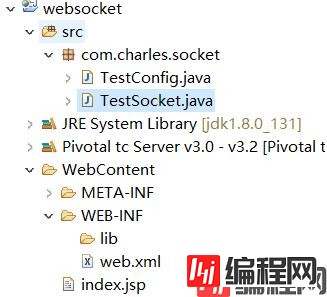Python 官方文档:入门教程 => 点击学习
目录使用websocket技术主动给前端发送消息WEBSocketConfigWebSocketServerwebsocket基础入门-前端发送消息项目结构如下图使用websocke
SpringBoot2.0对WebSocket的支持简直太棒了,直接就有包可以引入
<dependency>
<groupId>org.springframework.boot</groupId>
<artifactId>spring-boot-starter-websocket</artifactId>
</dependency> 启用WebSocket的支持也是很简单
package com.spark.common.config;
import org.springframework.context.annotation.Bean;
import org.springframework.context.annotation.Configuration;
import org.springframework.web.socket.server.standard.ServerEndpointExporter;
@Configuration
public class WebSocketConfig {
@Bean
public ServerEndpointExporter serverEndpointExporter() {
return new ServerEndpointExporter();
}
}
这就是重点了,核心都在这里。
因为WebSocket是类似客户端服务端的形式(采用ws协议),那么这里的WebSocketServer其实就相当于一个ws协议的Controller
直接@ServerEndpoint("/socketServer/{userId}") 、@Component启用即可,然后在里面实现@OnOpen开启连接,@onClose关闭连接,@onMessage接收消息等方法。
新建一个ConcurrentHashMap webSocketMap 用于接收当前userId的WebSocket,方便IM之间对userId进行推送消息。单机版实现到这里就可以。
package com.spark.common.utils.websocket;
import com.alibaba.fastJSON.jsON;
import com.alibaba.fastjson.JSONObject;
import com.spark.common.utils.StringUtils;
import lombok.extern.slf4j.Slf4j;
import org.springframework.stereotype.Component;
import javax.websocket.*;
import javax.websocket.server.PathParam;
import javax.websocket.server.ServerEndpoint;
import java.io.IOException;
import java.util.concurrent.ConcurrentHashMap;
@ServerEndpoint("/socketServer/{userId}")
@Component
@Slf4j
public class WebSocketServer {
private static int onlineCount = 0;
private static ConcurrentHashMap<String, WebSocketServer> webSocketMap = new ConcurrentHashMap<>();
private Session session;
private String userId = "";
@OnOpen
public void onOpen(Session session, @PathParam("userId") String userId) {
this.session = session;
this.userId = userId;
if (webSocketMap.containsKey(userId)) {
webSocketMap.remove(userId);
webSocketMap.put(userId, this);
//加入set中
} else {
webSocketMap.put(userId, this);
//加入set中
addOnlineCount();
//在线数加1
}
log.info("用户连接:" + userId + ",当前在线人数为:" + getOnlineCount());
try {
sendMessage("连接成功");
} catch (IOException e) {
log.error("用户:" + userId + ",网络异常!");
}
}
@OnClose
public void onClose() {
if (webSocketMap.containsKey(userId)) {
webSocketMap.remove(userId);
//从set中删除
subOnlineCount();
}
log.info("用户退出:" + userId + ",当前在线人数为:" + getOnlineCount());
}
@OnMessage
public void onMessage(String message, Session session) {
log.info("用户消息:" + userId + ",报文:" + message);
//可以群发消息
//消息保存到数据库、Redis
if (StringUtils.isNotBlank(message)) {
try {
//解析发送的报文
JSONObject jsonObject = JSON.parseObject(message);
//追加发送人(防止串改)
jsonObject.put("fromUserId", this.userId);
String toUserId = jsonObject.getString("toUserId");
//传送给对应toUserId用户的websocket
if (StringUtils.isNotBlank(toUserId) && webSocketMap.containsKey(toUserId)) {
webSocketMap.get(toUserId).sendMessage(jsonObject.toJSONString());
} else {
log.error("请求的userId:" + toUserId + "不在该服务器上");
//否则不在这个服务器上,发送到Mysql或者redis
}
} catch (Exception e) {
e.printStackTrace();
}
}
}
@OnError
public void onError(Session session, Throwable error) {
log.error("用户错误:" + this.userId + ",原因:" + error.getMessage());
error.printStackTrace();
}
public void sendMessage(String message) throws IOException {
this.session.getBasicRemote().sendText(message);
}
public static void sendInfo(String message, @PathParam("userId") String userId) throws IOException {
log.info("发送消息到:" + userId + ",报文:" + message);
if (StringUtils.isNotBlank(userId) && webSocketMap.containsKey(userId)) {
webSocketMap.get(userId).sendMessage(message);
} else {
log.error("用户" + userId + ",不在线!");
}
}
public static synchronized int getOnlineCount() {
return onlineCount;
}
public static synchronized void addOnlineCount() {
WebSocketServer.onlineCount++;
}
public static synchronized void subOnlineCount() {
WebSocketServer.onlineCount--;
}
}
TestSocket.java
package com.charles.socket;
import javax.websocket.OnMessage;
import javax.websocket.OnOpen;
import javax.websocket.Session;
import javax.websocket.server.ServerEndpoint;
@ServerEndpoint(value = "/helloSocket")
public class TestSocket {
@OnOpen
public void open(Session session) {
System.out.println("开始建立了链接...");
System.out.println("当前session的id是:" + session.getId());
}
@OnMessage
public void message(Session session, String data) {
System.out.println("开始处理消息...");
System.out.println("当前session的id是:" + session.getId());
System.out.println("从前端页面传过来的数据是:" + data);
}
}index.jsp 代码如下:
<%@ page language="java" contentType="text/html; charset=UTF-8" pageEncoding="UTF-8"%>
<!DOCTYPE html PUBLIC "-//W3C//DTD HTML 4.01 Transitional//EN" "Http://www.w3.org/TR/html4/loose.dtd">
<html>
<head>
<meta http-equiv="Content-Type" content="text/html; charset=UTF-8">
<title>Charles-WebSocket</title>
<script type="text/javascript">
var websocket = null;
var target = "ws://localhost:8080/websocket/helloSocket";
function buildConnection() {
if('WebSocket' in window) {
websocket = new WebSocket(target);
} else if('MozWebSocket' in window) {
websocket = MozWebSocket(target);
} else {
window.alert("浏览器不支持WebSocket");
}
}
// 往后台服务器发送消息.
function sendMessage() {
var sendmsg = document.getElementById("sendMsg").value;
console.log("发送的消息:" + sendmsg);
// 发送至后台服务器中.
websocket.send(sendmsg);
}
</script>
</head>
<body>
<button onclick="buildConnection();">开始建立链接</button>
<hr>
<input id="sendMsg" /> <button onclick="sendMessage();">消息发送</button>
</body>
</html>注意:
和后台交互的时候,一定要先点击:开始建立连接。你懂的...没有建立连接的话,是不能发送消息的。

先点击,开始建立连接,然后在文本框中输入内容:我是Charles,点击消息发送,在看后台日志。


以上为个人经验,希望能给大家一个参考,也希望大家多多支持编程网。
--结束END--
本文标题: springboot 使用websocket技术主动给前端发送消息的实现
本文链接: https://www.lsjlt.com/news/160298.html(转载时请注明来源链接)
有问题或投稿请发送至: 邮箱/279061341@qq.com QQ/279061341
下载Word文档到电脑,方便收藏和打印~
2024-03-01
2024-03-01
2024-03-01
2024-02-29
2024-02-29
2024-02-29
2024-02-29
2024-02-29
2024-02-29
2024-02-29
回答
回答
回答
回答
回答
回答
回答
回答
回答
回答
0